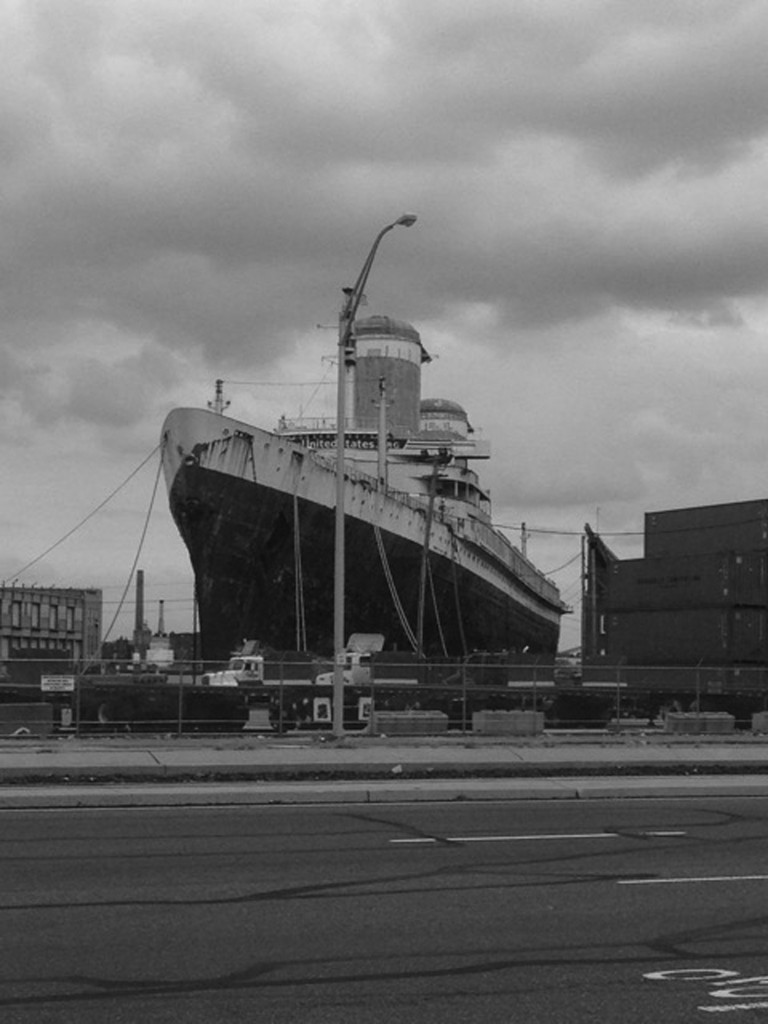When crossing the Benjamin Franklin Bridge on the way to Philadelphia, one may see the red, white, and blue stacks of an old ship off in the distance. She is the famous passenger liner, the “S.S. United States.” Known as “America’s Flagship,” the “S.S. United States” may have only weeks left to live.
Completed in 1952, the “United States” is the fastest ocean liner in the world. She was the first American ship in 100 years to capture the Blue Riband, the prestigious international award given to the fastest transatlantic ocean liner. She made the crossing in three days, 10 hours, and 42 minutes. The 990 foot long ship had reached a max speed of over 38.32 knots, or 44 miles per hour, becoming an instant American icon. 63 years later, the “United States” still holds this record — quite the testament to American ingenuity.
The “United States” was built as a Cold War secret project. The U.S. Navy had a large investment in the ship, and her designer, internationally-known maritime architect, William Francis Gibbs, designed her to be converted into a troop transport in the event of war.
Besides being the fastest, the “United States” was the most technologically advanced and luxurious ship of her day. Presidents, royalty, and Hollywood stars, such as Walt Disney, John Wayne, Bob Hope, and Marilyn Monroe, all traveled on her. Immigrants saw the Statue of Liberty from her decks, and families often made their summer vacations abroad her. Eastern University’s Dr. David Bradstreet recalls that one of his former teachers made annual trips on the “United States” and recounted her adventures onboard to her students.
The ship’s first captain, Harry Manning, thought that his ship could prove that his country could still build and sail record-breaking ships. Captain Manning, known as “America’s Captain,” was an overcomer who drove himself to conquer a lisp and his short stature. What he lacked in physical appearance he made up for in character. He would guide his ship through fog and storm without incident. To many Americans, Captain Manning was a hero, while to others he was reckless. The fact remains that his record, like the service record of the S.S. United States’, is unblemished.
Faced with the reality of economic hardship, and transatlantic air travel, the “United States” was removed from service in 1969. In the decades since her retirement she has had multiple owners, each with a different vision of what to do with her. No vision ever came to fruition. For nearly 20 years she has been tied to Philadelphia’s Pier 82, awaiting a new life.
The issues concerning the futre of the “S.S. United States” are centered on the question, “Is she worth saving?” Peter Knego, an ocean liner historian, stated that scrapping of the United States would be “the natural order of things.’’ Susan Gibbs, granddaughter of the ship’s architect and president of the “S.S. United States” Conservancy (the non-profit organization that seeks to preserve the ship) says the loss of the ship would be a national tragedy.
Recently, the Conservancy has announced that unless donors, investors, or buyers come forward to preserve the ship, “We will have no choice but to negotiate the sale of the ship to a responsible recycler.”
Critics of the Conservancy argue that “America’s Flagship” is out of date and belongs to the history books. Supporters of the Conservancy argue that there will never be another ship like her. Former President Bill Clinton states, “The S.S. United States is…a symbol of our country’s industry and accomplishment…the destruction of the United States would be tantamount to destroying other national monuments like the Liberty Bell or the Statue of Liberty…we must maintain what is good and constant in our past if we are to imagine a better future.”
“United States” architect, Mr. Gibbs, once said of his ship, “You can’t catch her, you can’t set her on fire, and you can’t sink her.” Indeed, in the eyes of those like Mr. Gibbs, the “United States” represents the country she was named after, and according to them, her destruction would mean the loss of an American treasure.
Sources: united-states-lines.org, ssusc.org, usatoday.com, mobile.nytimes.com

